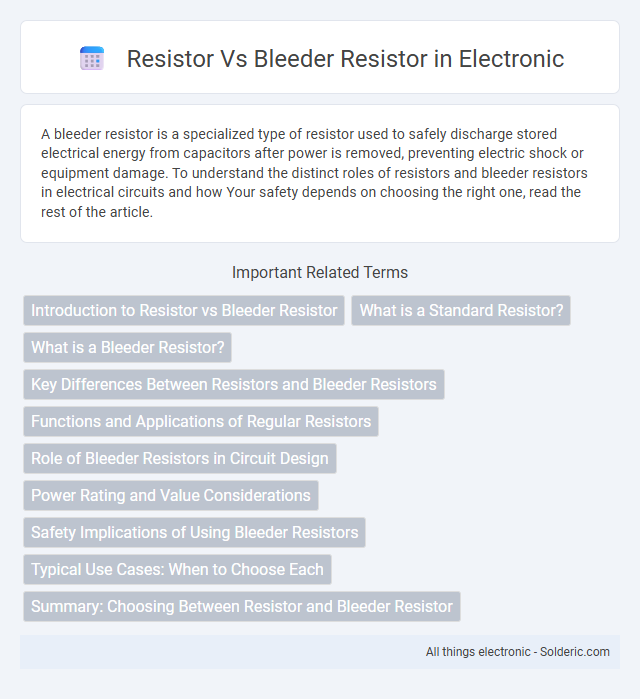A bleeder resistor is a specialized type of resistor used to safely discharge stored electrical energy from capacitors after power is removed, preventing electric shock or equipment damage. To understand the distinct roles of resistors and bleeder resistors in electrical circuits and how Your safety depends on choosing the right one, read the rest of the article.
Comparison Table
| Feature | Resistor | Bleeder Resistor |
|---|---|---|
| Primary Function | Limit current, divide voltage, or set operating conditions in circuits | Discharge stored voltage in capacitors after power off for safety |
| Common Application | General electronic circuits, signal conditioning, biasing | Power supplies, high-voltage capacitors, HV circuits |
| Power Rating | Varies widely depending on application (mW to several watts) | Typically higher wattage to safely dissipate stored energy |
| Resistance Value | Wide range, selected based on circuit needs | Relatively high to limit current while discharging capacitors slowly |
| Safety Role | No direct safety function | Prevents electric shock by discharging voltage |
| Usage Duration | Active during circuit operation | Active primarily after power off |
Introduction to Resistor vs Bleeder Resistor
A resistor is a passive electrical component designed to limit current and drop voltage within a circuit, affecting the overall resistance. A bleeder resistor specifically serves to discharge stored energy from capacitors in power supplies, ensuring safety by preventing electric shock when the device is powered off. Understanding the distinction helps optimize your circuit's performance and safety measures effectively.
What is a Standard Resistor?
A standard resistor is an electronic component designed to limit current flow and adjust signal levels within circuits by providing a precise resistance value. It is typically characterized by its resistance rating, power rating, tolerance, and temperature coefficient, ensuring consistent performance in various applications. Unlike a bleeder resistor, which is used specifically to safely discharge capacitors, a standard resistor serves general purposes such as voltage division and current control directly affecting your circuit's operation.
What is a Bleeder Resistor?
A bleeder resistor is a specialized resistor used to safely discharge stored electrical energy in capacitors or power supplies after the device is turned off, preventing electric shock or damage. Unlike a standard resistor that primarily controls current flow or voltage levels during circuit operation, a bleeder resistor ensures residual charge dissipation over time. You should consider using a bleeder resistor in high-voltage circuits to enhance safety and maintain component longevity.
Key Differences Between Resistors and Bleeder Resistors
Resistors primarily control current flow and voltage drop in circuits, while bleeder resistors specifically discharge stored energy in capacitors for safety. Standard resistors come in various values and power ratings for general use, whereas bleeder resistors are designed with high resistance and power dissipation capability to safely bleed residual charge. The key difference lies in their function: resistors regulate circuit parameters, bleeder resistors ensure capacitor discharge to prevent electric shock or damage.
Functions and Applications of Regular Resistors
Regular resistors control current flow and divide voltage in electronic circuits, ensuring components operate within specified limits. They serve crucial functions in signal conditioning, biasing active components, and limiting current to protect devices. Your circuit reliability depends on precise resistor values to stabilize performance and prevent damage.
Role of Bleeder Resistors in Circuit Design
Bleeder resistors serve a critical safety function by discharging stored electrical energy in capacitors after power is removed, reducing the risk of electric shock. Unlike standard resistors that primarily limit current or divide voltage during operation, bleeder resistors maintain a continuous current path to safely dissipate residual charge. Their integration in high-voltage power supplies and filter circuits ensures the quick discharge of capacitors, enhancing the overall reliability and user safety of electronic systems.
Power Rating and Value Considerations
Resistors require power ratings that match their application to prevent overheating, with typical values chosen based on current and voltage requirements. Bleeder resistors have lower resistance values specifically designed to safely discharge capacitors over time, ensuring residual voltage is minimized for electrical safety. Power ratings of bleeder resistors must be sufficient to handle continuous energy dissipation without compromising circuit performance.
Safety Implications of Using Bleeder Resistors
Bleeder resistors enhance safety by discharging stored electrical energy in capacitors after power is turned off, reducing the risk of electric shock during maintenance. Unlike standard resistors that primarily manage current flow, bleeder resistors ensure residual voltages drop to safe levels within seconds. This critical function helps prevent accidental injury and equipment damage, especially in high-voltage power supplies and capacitor banks.
Typical Use Cases: When to Choose Each
Resistors are typically used in electronic circuits to limit current, divide voltage, or provide biasing, making them essential for general circuit functionality and protection. Bleeder resistors are specifically designed to safely discharge stored energy in capacitors after power is turned off, preventing electric shock and ensuring circuit stability in devices like power supplies and high-voltage equipment. Choose a standard resistor for current control or voltage division within active circuits, while a bleeder resistor is the optimal choice for safety and energy dissipation in high-voltage or stored-energy applications.
Summary: Choosing Between Resistor and Bleeder Resistor
A resistor is primarily used to limit current flow and divide voltages in electronic circuits, while a bleeder resistor specifically discharges stored electrical energy from capacitors or high-voltage components to ensure safety and prevent electric shock. When selecting between a resistor and a bleeder resistor, consider the application requirements: use standard resistors for controlling circuit parameters and bleeder resistors for discharging purposes in power supplies or high-voltage circuits. Key factors include resistance value, power rating, and placement to ensure effective current regulation or safe voltage dissipation.
resistor vs bleeder resistor Infographic

 solderic.com
solderic.com